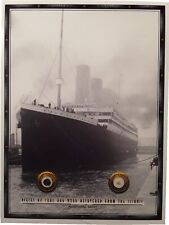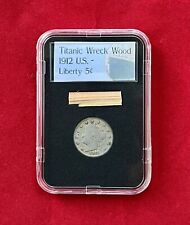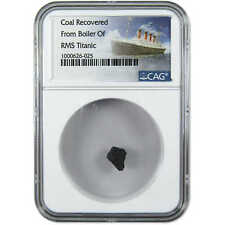When you click on links to various merchants on this site and make a purchase, this can result in this site earning a commission. Affiliate programs and affiliations include, but are not limited to, the eBay Partner Network.
Hello everyone!
Here it is for sale an unfoundable artefact from the RMS Titanic: a piece of steel from the Big Piece (largest piece of Titanic hull ever recovered, 20tons)This fragment fall from the Big piece during his transport, after the 1998 Atlantic city exhibition.It was taken by a witness. Then it was sold to David Vapnitsky who is a professional numismatic seller based in Las Vegas. Then it was sold to a collector who sold this piece to me.This fragment measures approx. 1.3cms x 1.1cms
It was treated by electrolyse, but has this fragment came from an angle of the Big piece, we still can see oxydation (rusticles) on it.
This piece attract magnet, as you can see on photographFOR VIEWING ULTRA MACRO PHOTOGRAPHIES, PLEASE CONTACT ME
This piece is provide with exclusive photos of the transport of the Big piece during Atlantic\'s exhibition, and a letter from the first owner to the second (David Vapnitsky) PHOTOCOPIES ONLY because I have other pieces I want to keep.For information, this sale will allows me to help me for my projects studies in design (I\'m student and collector)
NOTE: as I didn\'t received offers, I relist it in sale at a low price without reserve!
Here it is an explanation of the biodeterioration of the Titanic, found in Encyclopedia Titanica:
\"ne of the great icons of the twentieth century was born April 15, 1912 with the sinking of the RMS Titanic. At her launching, this great ship was the largest liner ever built and carried the distinction of being the biggest, the best, and even claimed to be \"unsinkable\". The sinking was made even more dramatic by the striking of an iceberg on her maiden voyage, with over 1500 lives lost. This single event has become burnt into societies\' consciousness as an image of arrogance and ignorance.
Myths and legends continued to surround the RMS Titanic until its discovery in 1985. The ship lies silently on the bottom of the Atlantic Ocean, over 500-km off of the coast of Newfoundland. The Titanic, torn into three parts and surrounded by a debris field, is scattered on a portion of the continental shelf at a depth of 3.9 kilometers, with a temperature of 1°C and pressures in excess of 6000psi. After 88 years at the bottom of this watery grave, the RMS Titanic shows signs of deterioration. This deterioration is found in the form of growth, coined rusticles that appear both inside and outside of the ship\'s structure. In 1996 and 1998, scientific expeditions to the site of the RMS Titanic have learned that the rusticles are growing larger and denser, while the ship continues to deteriorate. Microscopic evaluation revealed that the rusticles are complex bioconcretious structures involving many different consortia, or communities of bacteria and fungi, formed through cooperative activities. These integrated structures include water channels, porous sponge-like regions, rib-like structures, cavernous water reservoirs and thread-like columns that appear to bind these structures together along with resinous patches.
The bioconcretious rusticles vary in color, texture, size and form. The variation in color from a vivid yellow through to brown and even purple is due to the highly oxidized ferric iron content. These can be found on the outer surfaces of the Titanic. Rusticles can also appear to have a grey or black hue. These can be found in more reductive environments such as those found in the interior of the ship. The rusticles are dense structures, with a high iron content ranging from 24 to 36% consisting mostly as complex ferric oxides and hydroxides. The support structures of the rusticles appear to be dominated by matrices of heavily mineralized growth in which goethite is dominant. An iron oxide sulfate complex, known as green rust was also found (Fe+23.6Fe+30.9(O--, OH-, SO4--)9). Rusticles that have been recovered from the 1996 Expedition to Titanic have been analyzed by electron diffraction x-ray. This technique revealed that iron was the dominant atom within the range of atoms tested. The relationship within the bioconcretious structure is (dominant atom first): Fe > Na > S > Cl > Mg > Si > P > Mn. There is considerable variation in the elemental composition of the rusticles tested, however, this reflects the heterogeneous nature of the structures themselves.
The examination of the rusticle growth on the ship itself was done in both 1996 and 1998. This examinationin situshowed, visually, that the rusticles have a concrete looking exterior however, when approached and, when touched or disturbed through mechanical means, proved fragile and commonly shattered into numerous pieces, spewing a red, powder-like material into the surrounding water. This phenomenon was examined closer in a laboratory setting, using recovered rusticles. When growth occurred in the laboratory, the rusticles were fed various selective culture media through implanted hypodermic syringes simulating organic loading in the oceanic environment. Growth occurred very slowly but it was noted that there was a continuous release of material resembling the powder-like material first observed in situ, through the ducts leading from the structural water channels. This material, when dried, resembles red dust, having an iron content, on average, of 20+/-5%. Additionally, there were releases of biocolloidal yellow slimes with an average iron content of 8+/-3%. These releases totaled between 0.02 and 0.03% of the rusticle\'s biomass per day. If this were to be repeated in situ, tests indicate that it would take between nine and fourteen years for the same amount of iron to be released from the rusticles as equivalent to the amount of iron being held within the rusticles structure. From the 1996 surveys, it was determined that there was approximately 650 tons (dry weight) of rusticles on the outside of the bow section of the wreck. From this, it can be extrapolated that a daily loss of iron, as red dust and yellow biocolloids, of between 0. 13 and 0.20 tons per day could be occurring from the wreck. Further extrapolation reveals that iron in the bow section, assuming 20,000 tons of iron, and that the rusticles were removing the iron at a constant rate, could be totally exported into the environment as red dust and biocolloids in approximately 280 to 420 years.
Key in determining how long the Titanic may remain intact is the rate at which these biologically-driven rusticles will grow and extract iron from the steel plating of the ship. To examine this phenomenon, four IPSCO Test Platforms were placed down at the site of Titanic, in 1998. Each platform has three different types of maritime steel, each represented by five coupons, which have been either twisted, hammered, tempered or burnt, including a control sample. These platforms are still at the wreck site and early reports indicated that the rusticles are growing over the test coupons. When recovered, the rusticle growth and resident amount of iron in the coupons will be used to assess the rate at which iron extraction is occurring, the residence time in the rusticle for the iron and finally, the amount of iron already exported to the oceanic environment In addition to the IPSCO Test Platforms, there is a need to understand the nutritional factors influencing the growth of rusticles. On both the 1996 and 1998 expeditions, there were periods when the \"sea snow\', a mixture of biocolloids and zooplankton, was so intense that it resembled a blizzard on the prairies. This sea snow originates, in part, from the deep scattering layer located approximately 400-1000 meters below the surface, and partly from the growths over the ocean floor. After such a \"snow fall\", the rusticles become covered with a gentle coating of white slime that presumably, is able to be consumed by the rusticles through the ducts that perforate the outer structural coating.
The chemistry of this biodeterioration is clearly complex and certainly involves the growth of microbes at the reduction-oxidation front forming within the structures, and upon the electrical charges inherently present within the steel and modified by the rusticle growth. In the laboratory, it has been possible to manipulate the position, form and rate of rusticle growth by the application of electromagnetic forces to the steel. This has now become the subject of a patent application. Clearly the biodeterioration of the RMS Titanic is being driven by rusticles mining the steel for its iron which becomes the major structural support element in the rusticles, in much the same way as calcium provides the skeletal support in many vertebrates. In 1998, comparisons were made with video footage from the 1986, 1996 and 1998 expeditions to determine the rate of biodeterioration over time. The mass of rusticles has increased on the outside of the bow section by at least 30% between 1996 and 1998 and there are ongoing signs of deterioration. For example, the bow section of Titanic\'s Upper Promenade Deck is deteriorating from the aft, moving forward at a rate of approximately 30cms per year. Another indication that degradation is occurring is at the aft end of the bow section. All of the decking structures located at this point, having folded and collapsed over the aft section during impact, have now disintegrated away to reveal for the first time the boilers in Boiler Room #2. Cracks in the steel hull plating are also beginning to appear, particularly around the Well Deck, that suggests further deterioration is progressing. Inside the bow section, copious rusticles are growing throughout. These may also be leading to the gradual deterioration of the ship. It is only through a more intensive investigation that the true rate of this biologically driven deterioration can be predicted.\"









